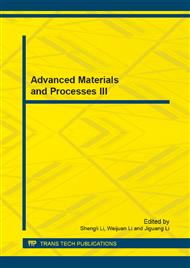[1]
Li Qinghai. Census work summary report of fluorite and barite ore in Southeast Sichuan. Chongqing: Geology NO. 107 of Chongqing, (1977). In Chinese.
Google Scholar
[2]
Sichuan Bureau of Geology and Mineral Resources. Regional Geology of Sichuan Province. Beijing: Geological Publishing House, (1987) . In Chinese.
Google Scholar
[3]
Li Wenyan, Yu Hongyun. Barite deposits in China. Beijing: Geological Publishing House, (1991) . In Chinese.
Google Scholar
[4]
Zou Hao, Xu zhanzhang, Zhang Shouting et al. The Ore-controlling factors and genesis of Huoshiya Barite-Fluorite ore deposit in Pengshui, Chongqing, Journal of Chengdu University of Technology(Science & Technology Edition). Vol. 40(1), pp.369-373, (2013).
Google Scholar
[5]
Ruiz J., Kesler S. E., and Jones L. M. Strontium Isotope Geochemistry of Fluorite Mineralization Associated with Fluorine-Rich Igneous Rocks from the Sierra Madre Occidental, Mexico' Possible Exploration Significance. Economic Geology, 80, pp.33-42, (1985).
DOI: 10.2113/gsecongeo.80.1.33
Google Scholar
[6]
Whitford. D.J., Korsch. M.J. and Solomon. M., Strontium isotope studies of barites: Implications for the origin of base metal mineralization in Tasmania. Economic Geology, Vol. 87, pp.953-959, (1992).
DOI: 10.2113/gsecongeo.87.3.953
Google Scholar
[7]
Pan Zhonghua, Fan Delian. Isotope Geochemistry of Vein FIuorite and Barite Deposits in Southeast Sichuan, Arta Petrologica Sinica. Vol. 12(1), pp.127-136, (1996). In Chinese.
Google Scholar
[8]
Huang Sijing, Shi He, Mao Xiaodong et al. Evolution of Sr Isotopes of the Cambrian Sections in Xiushan, Chongqing, and Ralated Global Correlation. Geological Review, Vol. 48(5), pp.509-516, (2002). In Chinese.
Google Scholar
[9]
Cao Juncheng, Li Benchao, Li Xinan, et al. Geochemistry of Stratabound fluorite deposits: Tu Guangchi et al. 1987. Geochemistry of Stratabound ore deposits in China. Beijing: Science Press, pp.157-196, 224-259, (1987). In Chinese.
Google Scholar
[10]
Zhang Xingyuan. Barite and Fluorite Stratabound Deposits in Southeastern Sichuan and Ore-Controlling Geological Conditions. Regional Geology of China, Vol. 4, p.369~373, (1988). In Chinese.
Google Scholar
[11]
Wang Guozhi, Liu Shugen, Chen Cuihua, et al. The genetic relationship between MVT Pb-Zn deposits and paleo-oil/gas reservoirs at Heba, Southeastern Sichuan Basin. Earth Science Frontiers, Vol. 20(1), pp.107-116, (2013). In Chinese.
Google Scholar


